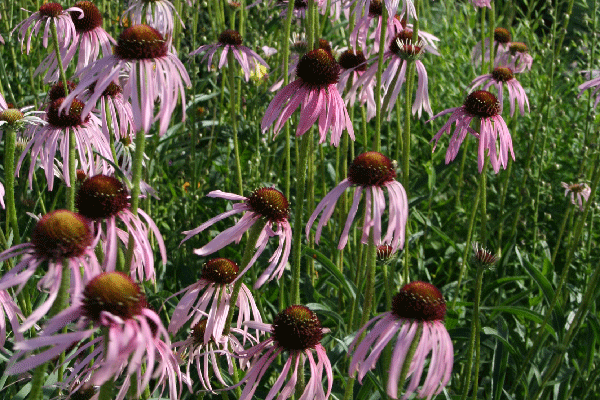“The joy of prairie lies in its subtlety. It is so easy—too easy—to be swept away by mountain and ocean vistas. A prairie, on the other hand, requests the favor of your closer attention. It does not divulge itself to mere passersby.” Suzanne Winckler
Less than one percent of the tallgrass prairie ecosystem that once stretched from Canada to Texas remains unplowed. Our rich prairie soils now make up some of the most productive farmland in the world… and there’s no turning back. But one thing we can do to preserve our natural heritage is to plant and utilize prairie plants in our yards and gardens.
They are worth planting not only for their beauty and unique sense of place but also for the very measurable way they adapt to extreme weather; prevent erosion; improve water, air and soil quality; and support biodiversity.
Create Your Own Prairie in the City
You don’t have to convert your entire yard to prairie to make a difference, just substitute a few prairie plants for some more commonly planted non-native species.
Here’s a few prairie plants that can be easily integrated into a planted landscape:
Pale purple coneflower, Echinacea pallida, is known for its slender, hairy leaves and shuttle-cock like flowers with droopy, widely-spaced petals that can flutter whimsically in a good mid-summer breeze. Grows relatively tall and prefers to grow against grasses or other vertical plants for added support.
Gayfeathers represent a diverse group of at least six species worthy of garden planting. The dotted gayfeather, Liatris punctata, which is one of the most wide-ranging natives has tiny dots that speckle its narrow leaves. Sometimes called blazingstar, this wonderful wildflower grows from a stout taproot that can go 15 feet deep and support clusters of tight flowering stems resembling lavender bottle brushes. The flower spikes attract many butterflies and other pollinators and appear in late summer, just when the garden needs a boost of color.
Milkweeds are commonly recommended for monarchs and studies are showing that swamp milkweed, Asclepias incarnata, is even more favored by monarchs than common milkweed. It is not as aggressive in spreading and continues after common milkweed begins to fade. Its long-lasting blooms on 3-4’ tall plants, make it a great cut flower as well and it will draw aphids away from other plants. Another reliable garden milkweed is the butterfly flower, A. tuberosa, with bright orange flowers on 18” tall and mounded plants. This mixed prairie native prefers drier, well-drained soils.
Aromatic aster, Aster oblongifolius, is named for the balsam-like aroma given off by its crushed foliage. This bushy plant grows only 18-24” high and is covered by a mass of blue-violet to purple daisy-like flowers in late fall that help give the garden one last splash of interest before cold weather sets in. The plant is becoming common in the nursery trade with many cultivars such as ‘October Skies’ and ‘Raydon’s Favorite’ selected and marketed in recent years.
Other great options for bloom from summer into fall include beebalm, black-eyed Susan, evening primrose, prairie onion, goldenrod and wild indigo. Planting switchgrass, bluestem, grama, sedge or prairie dropseed among them will hold up some of the taller wildflowers and offer structure and interest all year long.
Nebraska Statewide Arboretum is a nonprofit that works toward sustainable home and community landscapes through initiatives in education, public gardens and the environment. Plant and landscape resources at http://arboretum.unl.edu.

